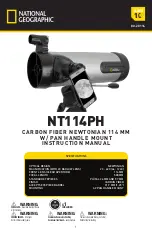
37
Training the Drive
Train the telescope motors using Autostar. Perform this procedure if you are experiencing any pointing accuracy prob-
lems.
Fig. 32
depicts the complete Drive Training procedure.
NOTE:
Use a terrestrial object, such as a telephone pole or lamp post, to train the drive. Complete this
exercise once every 3 to 6 months to maintain the highest level of telescope pointing accuracy.
DS-2000
TIPS
Fig. 32: Training the Drive
Press > until it
is centered
Press < until it
is centered
Train Drive
Az. Train
Train Drive
Alt. Train
Drive Setup
For this op. . .
Center reference
object
ENTER
ENTER
ENTER
ENTER
Scope slews left.
Bring target back
to center using
the Right Arrow key.
12
13
14
15
16
17
Scope slews right.
Bring target back
to center using
the Left Arrow key.
Menu returns to
Az. training.
Altitude
(vertical)
training.
Reminder to
use terrestrial
target.
Train Drive
Az. Train
Select Item
Object
Press until it
is centered
Press until it
is centered
ENTER
ENTER
MODE
18
19
20
21
Center target
using Arrow
keys.
Scope slews down.
Bring target back
to center using
the Up Arrow key.
Scope slews up.
Bring target back
to center using
the Down Arrow key.
Multiple presses.
ENTER
Select Item
Object
Select Item
Setup
Setup
Align
Setup
Telescope
3
4
6
ENTER
Press the scroll
up key once.
Access the Setup
menu.
Multiple presses.
Access the
Telescope menu.
5
ENTER
1
Telescope
Telescope Model
Telescope
Train Drive
Train Drive
Az. Train
Drive Setup
For this op. . .
Center reference
object.
ENTER
ENTER
ENTER
Multiple presses.
Choose the Train
Drive option.
Azimuth
(horizontal)
training.
7
8
9
10
11
Reminder to
use terrestrial
target.
Center target
using Arrow
keys.
ENTER
Verify that AUTOSTAR
INITIALIZATION is
complete.
Press MODE until
Select Item is displayed.
1
2
>
>
This manual gives only the briefest introduction to astron-
omy. If you are interested in pursuing further studies, a
few topics are suggested below that are worth reading up
on. Try looking up some of these topics in the Autostar
glossary.
Also below is a small sampling of books, magazines, and
organizations that you might find helpful.
Topics
1.
How is a star born? How does a solar system form?
2.
How is the distance to a star measured? What is a
light year? What is red shift and blue shift?
3.
How are the craters on our Moon formed? How old
is the Moon and Earth? How old is the Sun?
4.
What is a black hole? A neutron star?
5.
What are stars made of? Why are stars different col-
ors? What is a white dwarf? A red giant? Have we ever
seen the surface of a star besides our own Sun?
6.
What is a nova? A supernova?
7.
What are comets? Minor planets? Meteors? Meteor
showers? Where do they come from?
8.
What is a planetary nebula? A globular cluster?
9.
What is the Big Bang? Is the universe expanding or
contracting, or does it always remain the same?
What is dark matter?
10. What is an extrasolar planet? What is an accretion
(or protoplanetary) disk?
11.
What is the difference between an elliptical, a spiral,
and an irregular galaxy?
Books
1.
The Guide to Amateur Astronomy by Jack Newton
and Philip Teece
2. The
Sky:
A User’s Guide by David Levy
3.
Turn Left at Orion by Guy Consolmagno & Dan Davis
4. Astrophotography for the Amateur by Michael
Covington
Magazines
1.
Sky & Telescope
Box 9111, Belmont, MA 02178
2.
Astronomy
Box 1612, Waukesha, WI 53187
Organizations:
1.
Astronomical League
Executive Secretary
5675 Real del Norte, Las Cruces, NM 88012
2.
The Astronomical Society of the Pacific
390 Ashton Ave, San Francisco, CA 94112
3.
The Meade 4M Community
check out www.meade4M.org
And watch Jack Horkheimer,
Star Gazer, on your local
APPENDIX D
Looking at or near the
Sun
will cause
irreversable
damage to your eye. Do not point this telescope at or near the
Sun. Do not look through the telescope as it is moving.
Содержание DS-2000 Series
Страница 1: ...Instruction Manual DS 2000 Series Altazimuth Maksutov Cassegrain Telescopes MEADE COM...
Страница 43: ......








































